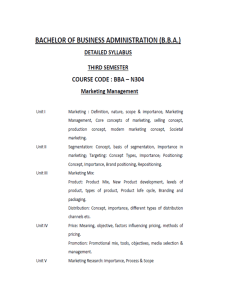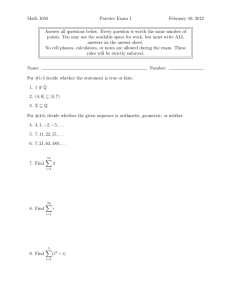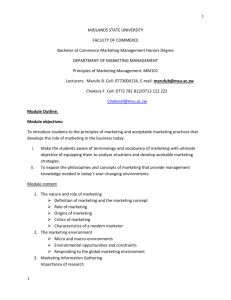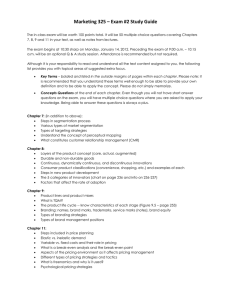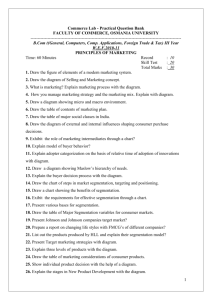PRICING TO SEGMENT CUSTOMERS Contents
advertisement
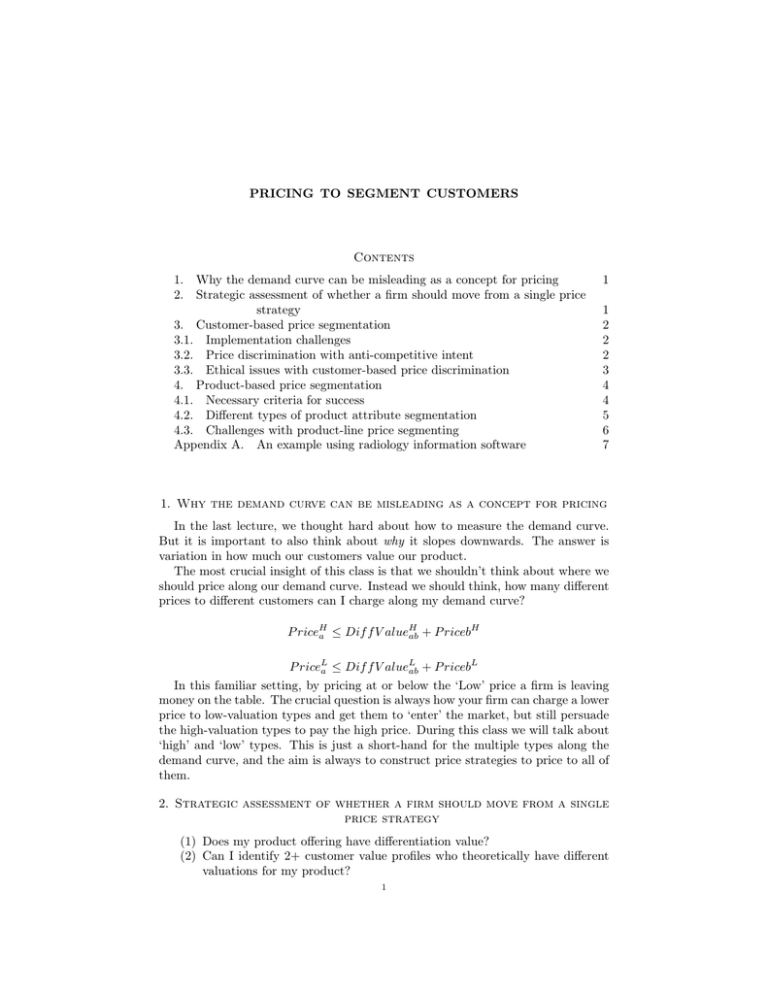
PRICING TO SEGMENT CUSTOMERS Contents 1. Why the demand curve can be misleading as a concept for pricing 2. Strategic assessment of whether a firm should move from a single price strategy 3. Customer-based price segmentation 3.1. Implementation challenges 3.2. Price discrimination with anti-competitive intent 3.3. Ethical issues with customer-based price discrimination 4. Product-based price segmentation 4.1. Necessary criteria for success 4.2. Different types of product attribute segmentation 4.3. Challenges with product-line price segmenting Appendix A. An example using radiology information software 1 1 2 2 2 3 4 4 5 6 7 1. Why the demand curve can be misleading as a concept for pricing In the last lecture, we thought hard about how to measure the demand curve. But it is important to also think about why it slopes downwards. The answer is variation in how much our customers value our product. The most crucial insight of this class is that we shouldn’t think about where we should price along our demand curve. Instead we should think, how many different prices to different customers can I charge along my demand curve? H H P riceH a ≤ Dif f V alueab + P riceb L L P riceL a ≤ Dif f V alueab + P riceb In this familiar setting, by pricing at or below the ‘Low’ price a firm is leaving money on the table. The crucial question is always how your firm can charge a lower price to low-valuation types and get them to ‘enter’ the market, but still persuade the high-valuation types to pay the high price. During this class we will talk about ‘high’ and ‘low’ types. This is just a short-hand for the multiple types along the demand curve, and the aim is always to construct price strategies to price to all of them. 2. Strategic assessment of whether a firm should move from a single price strategy (1) Does my product offering have differentiation value? (2) Can I identify 2+ customer value profiles who theoretically have different valuations for my product? 1 2 PRICING TO SEGMENT CUSTOMERS (3) Is there empirical evidence that these different customers actually have the EVC differences you expect them to have? • Very different price elasticities indicate that they do have different EVC. (4) Is there empirical evidence that customers in this value profile have similar enough EVC? • You can find out whether you have segmented enough, by trying to segment again. If the new price-elasticities that you calculate are no­ ticeably different from each other then you have not segmented enough. When marketers talk about customer segments, they are often thinking of a certain type such as ‘Denim Dads’, ‘Yoga Mommies’, or ‘Gen Y-ers’. However, when pricing analysts use the term ‘segmentation’, they are thinking of some­ thing far more specific. The aim of empirical analysis at all times is to identify and charge different prices to ‘High’ and ‘Low’ types. There are two main means of implementing segmentation: Customer-based and Product-attribute based. In customer-based price segmentation, the firm selects which prices the customer will pay based on their observable characteristics. In product-based price segmentation, the customer decides what price they will pay based on the product’s observable characteristics. The firm’s job is to create an appropriate pricing schedule and price fences between the different products. 3. Customer-based price segmentation 3.1. Implementation challenges. In customer-based price segmentation, the firm selects which prices the customer will pay based on their observable characteristics. (1) Unambiguous indicator of group membership • For example, veterinarians have veterinarian school certificates that the firm could demand be produced for a discount. (2) Characteristic must be correlated with EVC • This is not always clear cut. We saw this in the empirical example that we discussed in class, where the doctors had widely different valuations. This is problem too in the real world. – For example, Quickbooks had been charging existing customers less because it reckoned that they would value an upgrade less since they already had it. However, there was actually a split between those who valued it less and those who valued it more. (3) Product must not be tradeable across groups • An enterprising veterinarian could purchase the software and resell at a profit to a hospital. • This explains why customer-based segmentation is found mostly for services or experiences. 3.2. Price discrimination with anti-competitive intent. A seller charging competing buyers different prices for the same ‘commodity’ or discriminating in the provision of ‘allowances’ - compensation for advertising and other services ­ may violate the Robinson-Patman Act. This kind of price discrimination may give favored customers an edge in the market that has nothing to do with their superior efficiency. Price discrimination is generally lawful, particularly if they prices reflect PRICING TO SEGMENT CUSTOMERS 3 the different costs of dealing with different buyers or are the result of a seller’s attempts to meet a competitor’s offering. 3.2.1. Specific Legal Tests. (1) The Act applies to commodities, but not to services, and to purchases, but not to leases. (2) The goods must be of like grade and quality. (3) There must be likely injury to competition (that is, a private plaintiff must also show actual harm to his or her business). (4) Normally, the sales must be in interstate commerce (that is, the sale must be across a state line). 3.2.2. Anti-trust authorities look for. • Below-cost sales by a firm that charges higher prices in different localities • Price differences in the sale of identical goods that cannot be justified on the basis of cost savings or meeting a competitor’s prices; or • Promotional allowances or services that are not practically available to all customers on proportionately equal terms. 3.2.3. Outcomes from Robinson-Patman. • Merck would sell the drugs to hospitals at a 92% discount from the cat­ alog price, but only if the hospitals reached certain market shares for the drugs. Prosecuted for swindling Medicare/Medicaid by not offering these discounts. • Robinson-Patman explains why in Costco you enter a bizarre alternate universe of products for sale. Cereal comes in twin packs. Coke is available in cases containing 32 cans, not 24. Printer cartridges are sold in threepacks, not as singles or in pairs as at other stores. • Since the Brooke Group Ltd. v. Brown & Williamson and Volvo Trucks North America, Inc. v. Reeder-Simco GMC rulings there have been fewer successful prosecutions. Plaintiffs have to show harm rather than intent. 3.3. Ethical issues with customer-based price discrimination. (1) Price discrimination must be legal • In addition to Robinson Patman Act (1936): B2B regulation, EU de­ velopments • Wheeler Lea Amendment: Bans unfair or deceptive acts in commerce • Racketeer Influenced and Corrupt Organizations Act (RICO). Victo­ ria’s Secret’s differing catalog prices were prosecuted as mail fraud under this act. • Some state laws forbidding gender based price-segmentation.1 (2) Price discrimination must be culturally acceptable. It may be perceived as unfair or illegal even if it is not. • 2/3 of adult internet users believe that it is illegal for online retailers to charge different people different prices.2 1See ‘Is Ladies’ Night Legal?’, Gelf Magazine, September 2007 2‘Online shoppers seem naive about prices: Consumers unaware of ‘price customization,’ study finds’, Associated Press, June 1 2005 4 PRICING TO SEGMENT CUSTOMERS • Bloomberg waged a war on a Chinese restaurant that charged $1 more on its English menu, though it was difficult to find a law to prosecute under. • Controversy of supermarket chain that had unique ‘10 percent’ mark­ up for stores targeted at Hispanic shoppers3 • Sometimes, just sometimes, this can be resolved by better framing. – Disney customer-based discrimination would be a lot less palat­ able if they said they are going to charge more for adults, than if they said, as they do now, they are going to offer discounts to kids. (3) Privacy Issues • Customer-based price discrimination that makes use of past customer data is often felt to encroach on a customer’s privacy. This is becoming more important in Europe, and latterly so in the US. (4) We worry about the ethical nature of price discrimination. I would argue, however, that when a company does not price-segment because it can’t find appropriate metrics, then this can lead to just as bad consequences. For example, in the early 2000s 90% of those who suffer from AIDS could not afford the prices charged for AIDS drugs. The feeling that such a practice is not fair can be ascribed partly to a feeling of customer powerlessness. This has led firms to redesign their price segmentation strategies to emphasize that customers have a choice into which bucket they fall. 4. Product-based price segmentation In product-based price segmentation, the customer decides what price they will pay based on the product’s observable characteristics. The firm’s job is to create an appropriate pricing schedule and to maintain appropriate price fences between the different products. 4.1. Necessary criteria for success. (1) Can identify an unambiguous component of differentiation value correlated with overall EVC (e.g. convenience). Structure product accordingly. (2) ‘Distortion’: This component of differentiation value must be correlated strongly enough with overall EVC that high-valuation types will pay a premium rather than not have it. Or in other words, you are going to force your low-valuation types to signal that they have low-valuations because you are going to distort your product quality downwards. • Comfort, Speed, Reliability, Ease of use are good places to start. (3) ‘Compensation’: This component of differentiation value must be not so essential that low-valuation types will never buy the product without it. Price to compensate them. This is why we see discounts for economy class discomfort. I illustrate analytically the concepts of ‘Distortion’ and ‘Compensation’ in a detailed mathematical illustration in the appendix to this handout. Though this is a highly analytical concept based on economic ideas of signaling, this is actually the place where pricing becomes more of an art than a science. You will need the 3See ‘9 questions with Nash Finch Co.’ and ‘Some grocery stores add 10 percent fee’, Dan Boniface, 9news.com, October 10, 2008. PRICING TO SEGMENT CUSTOMERS 5 skill to identify a product feature or aspect of your product, where you can distort quality downwards and ultimately not annoy your customers. An obvious place to start is to reframe the product choice as the idea that you are distorting product quality upwards from the low-value product, rather than vice versa. 4.2. Different types of product attribute segmentation. (1) Reliability • Commercial oven thermometers cost 10 times more than oven ther­ mometers aimed at the domestic market, because they promise within 2 degree accuracy rather than within 10 degree accuracy. Here the low-valuation type have to signal that they are willing for their baked goods to not always come out in a perfectly consistent manner. (2) Capacity • Charging $199 for the 8GB IPhone, and $299 for the 16GB IPhone. Here the low-valuation types have to signal that they will not be using a full range of the multimedia capacity of the IPhone. (3) Pleasantness • Sales rep in charge of ‘economy line’ at printing company that delivered materials to non-profits was deliberately chosen to be unpleasant.4 (4) Convenience of Purchase • The classic example here is coupons. There were 253 billion coupons issued in 2005. Low-valuation types have to signal their low valuations by going to the bother of clipping and remembering the coupon. (5) Quantity • Low-valuation types signal their type by forgoing bulk discounts. (6) Channel • Bestbuy.com has better prices than Best Buy stores, but a low-touch environment. Those with low valuations have to signal this by being prepared to not see the product before they purchase it. (7) Geography • Supermarkets charge different prices depending on location. Often, however, such price differences are more a reflection of local competi­ tion than strategic price-segmentation.5 (8) Add-on Pricing • The classic example of add-on pricing is where a hotel separates out its low-valuation types (vacationers) from its high-valuation types (busi­ ness people) by charging for incidentals such as internet access. Lowvaluation types have to signal their low values by being willing to go without internet.6 • This kind of price-segmentation is very like feature-based price seg­ mentation except that the feature is explicitly optional. • The problem is that it can begin to feel like extra fees, which are separately painful each time a customer incurs them. 4Another example is ‘The Mystery of the Rude Waiter: Why my favorite restaurant employs such a churlish lout, Tim Harford, Jan. 21, 2006’ 5See ‘Wal-Mart Price Discrepancies Investigated’, September 22 2008, WKMG News. 6 See How Much Should Hotel Web Access Cost? Sometimes it’s free. Sometimes it’s $20 a day. Why? By Steven E. Landsburg, Slate.com Wednesday, Feb. 1, 2006 6 PRICING TO SEGMENT CUSTOMERS (9) Timing of Delivery • High-valuation types are willing to pay more for early delivery of goods. This can be as simple as charging a premium for express shipping. Or it can be as complex as skimming your initial market and pricing high for early adopters, and then lowering prices for late adopters. Lowvaluation types therefore have to signal their low valuations by waiting for the product to go mass-market. These kind of skimming strategies, however, can lead to customer unhappiness, as we saw in the case of Apple with their IPhone pricing. 4.3. Challenges with product-line price segmenting. (1) Finding attributes that correlate with EVC • For example, a skateboard manufacturer sold a premium line of skate­ boards with better wheels and colors, and also a discount strippeddown line where there were few patterns and the wheels were obviously plastic. The stripped down basic skateboards sold out, and actually resold for higher prices on eBay than the non-stripped premium ver­ sion. (2) Ensuring the integrity of the different products within the product line is maintained. • Customers can re-engineer low-segment products. For example, GPS for boating was re-engineered to work for airplanes. (3) Perceived fairness for low-segment users • A catalog company found a negative effect on all sales for including differential pricing for ‘plus-sizes’ • Dell faced a backlash from all customers for its new XPS pricing scheme, where ‘high-value’ customers got access to faster technical support. (4) Price segmentation can unwittingly reveal your costs. • Fast-setting bandage material manufacturer revealed just how cheap its product was to make when it started selling its product as a novelty craft item. (5) Can create bad publicity if price fences are found out • Best Buy got caught out with a secret website that customer service reps showed in-store customers, that supported its policy of charging less on the internet than in stores.7 (6) Cost-Effectiveness of Separation • Maintaining different product features can be expensive. This can mean that it may in limited circumstances be necessary to discon­ tinue product-based price segmentation. For example, a baby carrier company had to discontinue organic line as it was too expensive to manage. • Sometimes product segmentation goals can be lost to short-term profit goals. For example, Alamo and National decided to co-locate their car rental services. 7Press Release: Attorney General, DCP Commissioner Sue Best Buy For Deceiving, Over­ charging Customers, May 2007. PRICING TO SEGMENT CUSTOMERS 7 • A similar story is true for rebates, which started off with the same premise as coupons, but retailers got addicted to slippage and people forgetting to send their rebate forms in. (7) Need pricing power • The problem here is generally non-strategic competitors. You are only able to maintain price fences while your competitors co-operate. – Some surprising industries are able to sustain the kind of pricing power that you need for price segmentation. For example, dry cleaners persist in charging more for women’s blouses than men’s shirts. 8 – However, in ad-metrics industry a profitable add-on used to be trademark infringement monitoring services, since these were of interest predominantly to lawyers and other ‘high-valuation types’. However, profitability of this segment has been chal­ lenged by ‘one-price-fits-all’ start-ups. Appendix A. An example using radiology information software A radiology imaging services firm makes software that stores radiology images. The marginal cost of this software is zero. There are two potential groups of customers for this product: Hospitals and Veterinarians. The differentiation value of this software is that it allows a healthcare provider to compare and contrast more than one image at a time. In fact it actually allows them to compare up to 10 images at once. Both Veterinarians and Hospitals prefer to be able to look at more images at once, than not. However, hospitals value the ability to compare up to 10 images more than Veterinarians do, because the human anatomy is far more complex than the average dog or cat anatomy. The ideal strategy. There are QH Hospitals and QL Veterinarians who compose the market for this software. The EVC equations are simplified by assuming that because this software is so unique the appropriate reference product is no purchase, which has a price of zero. PH ≤ DVHA + DVHB PL ≤ DVLA + DVLB At the moment the firm is following a “penetration” pricing strategy where they price at DVLA + DVLB = PL to everyone in order to maximize sales. Therefore profits are Πcurrent = PL (QH + QL ) In a dream world, the firm would divine whether the customer is a High or Low type and charge them accordingly. The profits of doing so would be equal to Πdream = PH QH + PL QL This would increase profits over the firm’s current pricing strategy by (PH − PL )QH . In the real world, however, the software firm would be worried that if they 8Taken to the Cleaners? Nobody can explain why laundries charge less for men’s shirts than for women’s, even E. Landsburg, Slate.com. July 3, 1998 8 PRICING TO SEGMENT CUSTOMERS charged a Veterinarian one price and a Hospital another price for this software, as the Veterinarian would just resell it to the Hospital. Product-based price segmentation. Product-Based Price segmentation is where the design of the product is such that it encourages customers to signal whether they are a high-valuation or a low-valuation type through their choice of product. Highvaluation types value the software more in two dimensions: the number of images it can composite (A) and high-quality documentation that facilitates the use of the software (B). The high-valuation types value the number of composite images more. DVHA > DVLA The high-valuation types also value the documentation more. DVHB > DVLB The challenge is how to use these differences in valuations to segment the market. Let the firm designs two products. • Complete product • Discount product (which has no documentation). The aim is to ensure that high-valuation types choose the complete product and the low-valuation types choose the discount product. In particular, high-valuation types must be deterred from pretending to be low-valuation types and buying the discount product. Therefore the price of the complete good needs to be less than the net benefits of the discount good given its lower price and lower differentiation value. But this is simply the binding EVC equation. P C = P D + DVHB . For high-valuation types, the reference product is now endogenously determined by the choice of price for the discount product. For low-valuation types, the outside option is still no software with a price of zero. To ensure that they buy the product, the firm needs to price at: P D = DVLA . Therefore, recognizing that by offering this discount product the reference price has now changed for high-valuation types, means that the firm prices the complete product at: P C = DVLA + DVHB . How do these prices do compared to the perfect segmentation ideal? Ideally, the firm would charge low-valuation types: PL ≤ DVLA + DVLB But under product-based segmentation, the firm instead charges low-valuation types: PRICING TO SEGMENT CUSTOMERS 9 P D = DVLA Therefore the firm distorts prices downwards by DVLB , to compensate lowvaluation types for the fact that they have to choose not to get the documentation to signal that they are the low-valuation type. Ideally the firm wants to charge high-valuation types a price of: PH ≤ DVHA + DVHB But under product-based segmentation, the firm instead charges high-valuation types: P C = DVLA + DVHB Therefore the firm distorts price downwards by (DVHA − DVLA ) to bribe the high-valuation type to buy the non discount product. A.0.1. Profitability. For product-based price segmentation to be profitable requires it to be more profitable than current pricing practices. Πpbsegmentation ≥ Πcurrent = P C QH + P D QL ≥ PL (QH + QL ) (DVLA + DVHB )QH + (DVLA )QL ≥ (DVLA + DVLB )(QH + QL ) Therefore the profitability condition for customer-based price segmentation is: (DVHB − DVLB )QH ≥ QL DVLB MIT OpenCourseWare http://ocw.mit.edu 15.818 Pricing Spring 2010 For information about citing these materials or our Terms of Use, visit: http://ocw.mit.edu/terms.


